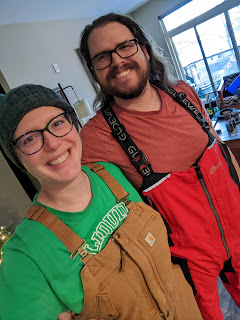Prague: 30 August - 3 September
Plzen: 3 September
We travelled to Prague after Wroclaw because Wil thought that I would want to see a fairytale city. He was right! Prague is all cobblestone streets, ancient castles and churches, and multicolored apartment and shop buildings all squashed together. Outside the old city there is plenty of industrialization as well, but we found enough in the old city to occupy ourselves.
 |
| Prague Castle (center) and the Charles Bridge (right) from the street outside our hostel. |
Though legend says Prague was founded in the year 800, the region became the seat of dukes and kings of Bohemia 100-200 years after that. It began as a few small, self-governed cities that eventually combined into what is now central Prague, along the river. While the first foundations for Prague Castle date from the late 800s, and the Basilicas of St Vitus and St George followed soon after, construction served to continually update the castle and basilicas (especially after fires and the like). St Vitus and St George Cathedrals now grace the grounds of Prague Castle. The famous Charles Bridge and associated towers, which stand to this day, were constructed in the late 1300s. Prague was also home to an enormous Jewish population prior to WWII. Please enjoy some pictures!
 |
| St Vitus Cathedral in Prague Castle, first founded by St Wenceslaus (a Bohemian king) in the 900s. The current cathedral was founded in the 1300s. |
 |
| Inside the cathedral. The audioguide was $30 so I have no idea what this is, but (like everything else in the cathedral) it is gorgeous and very, very old. |
 |
| Sample of St Vitus's stained glass artwork. |
 |
| Vladislav Hall in the Royal Palace. |
 |
| Torture chamber, because what 1000+ year old castle doesn't have a few? |
 |
| Inside St George Basilica, the oldest surviving church building on Prague Castle grounds. Original structures from the 10th century still survive here. |
 |
| Dexter enjoyed the medieval weapons museum. |
 |
| St George attempting to slay Dexter! |
 |
| Famous astronomical clock, a medieval feature of Prague's central square in the old town. Every hour as the clock chimes, figures of the Apostles and others emerge and move around. Installed in the early 1400s, this is the world's oldest working astronomical clock! |
 |
| One of the many Cerny sculptures scattered around the city. This one is on the German embassy grounds, so you have to walk around the back of the embassy and look through their fence--there's a sign right by the fence about the sculpture. I think they're used to people doing this, but we didn't stay too long! |
On our last day in the Czech Republic we took a day trip to Plzen, the city where Pilsner Urquell is brewed. Plzen was of some royal importance and is nearly as old as Prague. Since the 1200s, the residents of the city have been brewing beer. However, there were hundreds of "breweries" as there were no standards; everyone just made their own and tried to sell it. Eventually they ended up dumping barrels and barrels of beer in the streets because it was all undrinkable, and decided to organize and produce good beer. They ended up with Pilsner Urquell, first brewed in 1842 using water from an underground reservoir and Bohemian hops and barley. The Pilsner name became so synonymous with quality that people other places started calling their beers pils/pilsens as well. If you like light hoppy beers such as Stella Artois and Heineken, you have Plzen to thank. We got to drink unfiltered, unpasteurized beer straight from a huge oak keg!
 |
| Wil and Dexter share a beer-appreciation moment. |
 |
| Unfiltered, unpasteurized beer, straight from a barrel in underground storage. |
 |
| That beer was SUPER TASTY. |
 |
| They had a restaurant. I ate this. It was nearly as amazing as the underground beer. |

















Comments
Post a Comment